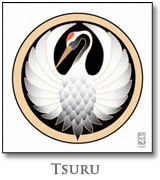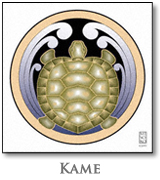|
|
|
|
|
…is an old Japanese saying describing the symbols of youth and old age (long life), the Tsuru (crane) and Kame (tortoise). In Japan, every element of the natural world has a sacred side for Shinto, and the religion promotes harmony between the divine, humans, and nature. A lofty tree, a towering waterfall, or a wondrous mountain were believed to possess kami and were made objects of worship, and the sea was recognized as the source of life. |
|
The Tsuru (crane) is one of the most commonly used symbols of long life in Asian legend and art. The Chinese consider the tsuru “the patriarch of the feathered tribe”. In Japan, the tsuru is a sacred bird that is said to live 1,000 years. If it lives 2,000 years it then turns black. |
 |
|
The kame (turtle synonymous with tortoise) is said to live 10,000 years and is one of the four celestial guardians (dragon, phoenix, tiger and turtle) of Chinese mythology. Symbolic of long life, the kame represents the water element, the yin principle, the northern region and the color black. The turtle is also called the “Black Warrior”, a symbol of strength, endurance and longevity. |
 |
Return to EDL
Collection
GO TO Home Page | Library Books | Tsuba Collective | Study Guide | E-MAIL